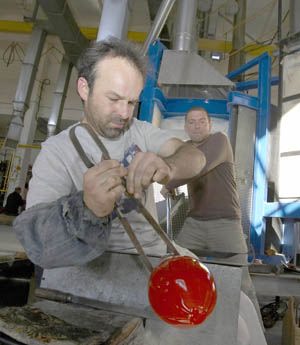A glassblowers’ symposium
International forum held in Novy Yar, Lviv oblast
It was the eighth symposium to be held under the aegis of the National Academy of Art of Ukraine. As previously, it was organized by Lviv’s National Academy of Art, and for the first time by Halytske Sklo Co.
Dr. Andrii Bokotei, chairman of the organizing committee, told The Day that noted glassblowers came to Ukraine from Australia, Austria, Great Britain, Estonia, China, Lithuania, Latvia, Luxembourg, Poland, Russia, the US, Turkey, Hungary, France, and the Czech Republic. In fact, some of them have taken such a keen interest in collaborating with Lviv-based glassblowers that they have attended several such symposiums already. Among these people was Matt Duran (UK). He said that it was his fourth visit to Ukraine, for a number of reasons — he liked the people and the atmosphere, he was interested in Ukrainian culture, which is very different from that of the UK. He went on to say that he was a craftsman who worked at home, using a variety of techniques, that glassblowing used miraculous material that had a life of its own, and that he tried to catch the light in it.
Another glassblower, Remigius Kriukas from Panevezys, Lithuania, is a veteran participant of this symposium: “It would be hard put to provide a short explanation about what attracts me to such projects. One of the reasons must be the atmosphere, as warm as that in which we work, blowing and working on our glass bubbles. I felt it the first time I came to your city. Back home, I also do glassblowing in my studio, so I know the hardships involved, and how you feel happy every time you produce a real work of art.”
Glassblowing is an art in itself, in that the glassblowers have to work manually, close to the glass-melting furnace, under high temperature, and using special techniques. Glassblowing dates back to the 3rd-4th centuries A.D. Numerous archaeological diggings in Ukraine reveal glass-melting furnaces dating back to Kyivan Rus’. This craft was stopped by the Golden Horde and was revived in the 14th century. “Glass has its advantages and risks. Glassblowing is blitz work. An artist can take his time painting a picture. In glassblowing, 30 minutes is precisely how long you have; any longer and you might as well use a sledgehammer to do away with your work. Here you must think fast and improvise. A creatively-minded glassblower must have perfect command of the relevant techniques, but also a special vision of the world around him; he must be different from other people; he must have a special energy source. Works of art produced by a glassblower who has this strong energy speak for themselves,” says Andrii Bokotei.
Alongside this international symposium, Lviv traditionally hosts a student one on the premises of Lviv’s Art Academy’s glassblowing chair; here they have two furnaces where Lviv’s glassblowers share their professional experience and creative ideas with counterparts from Latvia, Turkey, Russia, and China.
According to the symposium’s regulations, each glassblower has to submit one of his works to the City of Lviv, as a contribution to the stock of the local Glassblowing Museum (it currently boasts 300 unique items). The important thing is that, alongside the works on display, created by internationally reputed glassblowers, are those submitted by their younger counterparts.
The symposium’s program included an exhibit of paintings and prints, displayed in the same halls as those used for glassblowing. The exposition was launched on October 11, 2010, at the Andrii Sheptytsky National Museum.






